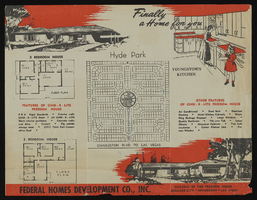Search the Special Collections and Archives Portal
Search Results

Film transparency of a ghost town, Delamar, Nevada, 1956
Date
1956
Archival Collection
Description
Some of the abandonded buildings in Delamar, Nevada. A tailing pile from one of the mines is visible in the center of the photograph. A stone structure is visible on the right side of the photograph. Delamar, Nevada, nicknamed The Widowmaker, is a ghost town in central eastern Nevada, USA along the east side of the Delamar Valley. During its heyday, primarily between 1895 and 1900, it produced $13.5 million in gold. In 1889, prospectors John Ferguson and Joseph Sharp discovered gold around Monkeywrench Wash. A mining camp was then born west of the Monkeywrench Mine. It was called Ferguson. In April 1894, Captain Joseph Raphael De Lamar bought most of the important mines in the area and renamed the Ferguson camp as Delamar. In the same year, a newspaper called the Delamar Lode began publication and a post office was opened. Soon, the new settlement boasted more than 1,500 residents, a hospital, an opera house, churches, a school, several businesses and saloons. Most buildings were made of native rock. By 1896, the Delamar mill was handling up to 260 tons of ore daily. Water for the camp was pumped from a well in Meadow Valley Wash, some twelve miles away. Supplies and materials traveled even further, by mule team over mountainous terrain from the railroad head at Milford, Utah, which was 150 miles from Delamar. Silicosis The gold in the Delamar mines was embedded in quartzite which when crushed created a fine dust. Miners breathing the dust often developed silicosis and the town became known as a "widow-maker." Many ruins now stand semi-intact in the Delamar ghost town region. Foundations can easily be seen from adjacent hills. There are two graveyards, which have been vandalized. The area is honeycombed with mines and mineshafts, but in recent years the main shaft has been blasted closed. Wild horses roam the area. The nearby dry lake is known to pilots as Texas Lake because its outline resembles the state of Texas.
Image

Untitled unpublished manuscript by Roosevelt Fitzgerald
Date
1970 (year approximate) to 1996 (year approximate)
Archival Collection
Description
From the Roosevelt Fitzgerald Professional Papers (MS-01082) -- Unpublished manuscripts file. "Injustice Blacks Have Suffered…" ending with Naomi Long Madgett's poem "Midway."
Text
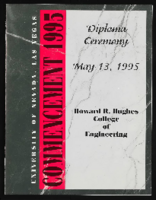
University of Nevada, Las Vegas (UNLV) Howard R. Hughes College of Engineering Diploma Ceremony program
Date
1995-05-13
Archival Collection
Description
Commencement program from University of Nevada, Las Vegas Commencement Programs and Graduation Lists (UA-00115).
Text
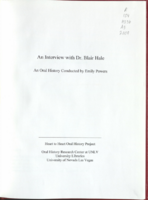
Transcript of interview with Blair Hale, by Emily Powers, June 16, 2006
Date
2008-06-16
Archival Collection
Description
Dr. Blair Hale has been practicing dentistry in Las Vegas for over thirty years. He was born in Idaho in 1949, the third of four children born to Zendal McKay and Lenny Raymond Hale. His education includes semesters at BYU, El Camino City College, and a dental degree from Washington University. Dr. Hale recounts his experiences as an undergraduate at Washington University in Missouri, living in a dorm situation and signing for government loans. He also examines his early days in Las Vegas and the ease with which he obtained bank loans to start his business back in 1976. At that time there were relatively few dentists practicing in Las Vegas, and when he was the dentist society president in 1985, he knew most dentists by name. Blair explains his work with the Academy of LDS Dentists, which sends groups of dentists to Guatemala, Peru, Honduras, and the Dominican Republic to run week-long free clinics. The clinics not only treat the dental problems of the populace, but also serve as instructional seminars for local practitioners. In addition to running a practice and doing charitable work outside the country, Dr. Hale also teaches at UNLV's dental clinic one day per week. He describes the changes in technology, technique, and materials over the years, and the quality education future dentists receive at UNLV. He also delineates the differences dental work can make in a patient's life, not just aesthetically but emotionally and physically as well. Dr. Hale comments on the dynamics behind the large influx of dentists in the 90s, the future of health care in Las Vegas, and the impact of third-party carriers in the dental profession. He believes that dentistry is a wonderful profession and that students can receive an excellent education at any good dental school in the United States. His sons are contemplating following him into this field.
Text

Postcard of a barge, Lake Mead, circa 1935-1950
Date
1935 to 1950
Archival Collection
Description
Picture of the first load of gold ore to be transported on Boulder Lake by barge.
Image
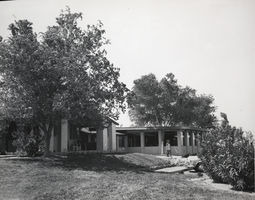
Photograph of the exterior of the Lake Mead Lodge, Nevada, circa 1940s to 1950s
Date
1940 to 1959
Archival Collection
Description
A black and white side view of the front exterior of the Lake Mead Lodge.
Image
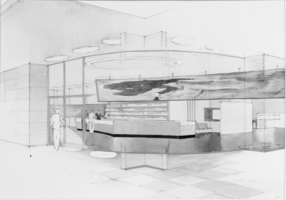
Film transparency of an architectural drawing, Nevada, circa 1930s-1940s
Date
1930 to 1949
Archival Collection
Description
A close up architectural sketch of the Boulder Dam Visitors Bureau.
Image

Film transparency of Lake Mead National Recreation Area administrative building, circa 1940s-1950s
Date
1940 to 1959
Archival Collection
Description
An image of the Lake Mead National Recreation Area administrative building.
Image
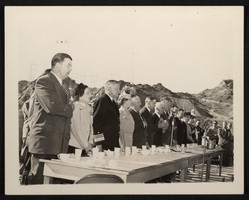
Photograph of the Rotary Club, Hoover Dam, circa October 1946
Date
1946
Archival Collection
Description
An image of Rotary Club members standing to sing the national anthem.
Image
Pagination
Refine my results
Content Type
Creator or Contributor
Subject
Archival Collection
Digital Project
Resource Type
Year
Material Type
Place
Language
Records Classification

